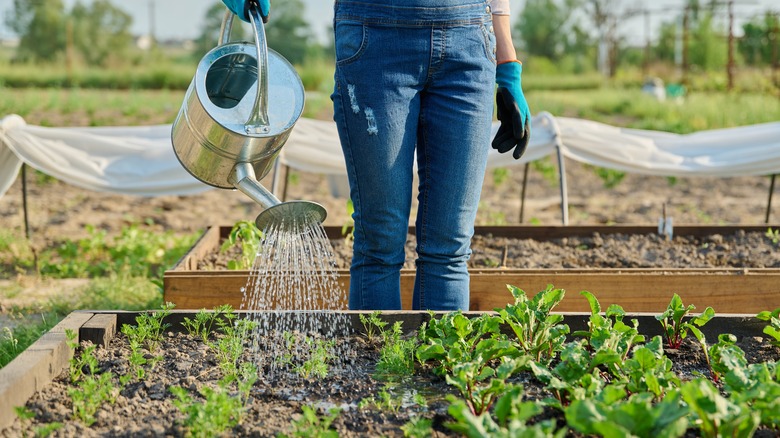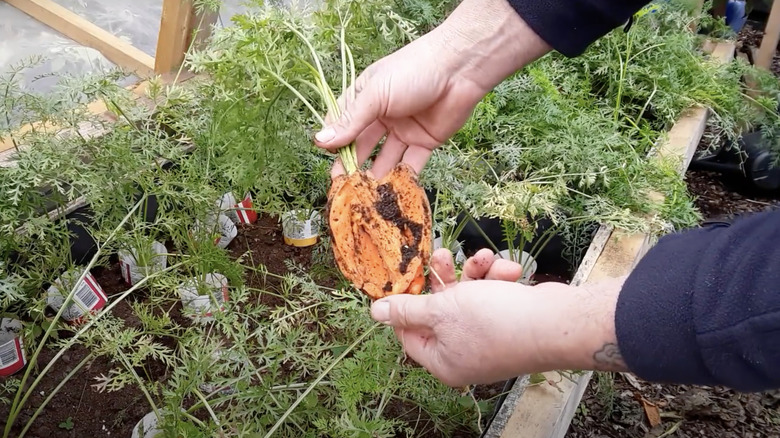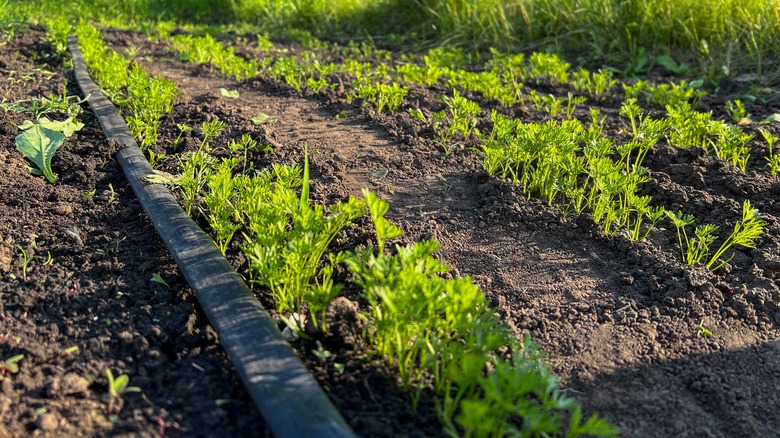The Bizarre Sign Your Homegrown Carrots Had A Major Watering Problem
We may receive a commission on purchases made from links.
You've mastered your climbing vegetables, the juicy heirloom tomatoes, wiry green beans, and crisp cucumbers, and your tall leafy kale, spinach, and Swiss chard plants couldn't be perkier. Now, you're turning your attention to vegetables that grow underground and tips for a successful root garden. Outside of preferring sandy soils and sun, carrots thrive on neglect. So it may come as a surprise when you cut into your freshly harvested carrot and see neat, vertical holes surrounding the core. In other or older carrots, these internal splits may branch out into full-blown cracks. Carrots are targeted by a number of exoskeletal pests, including carrot rust flies, wireworms, and vegetable weevils, whose hungry larvae carve tunnels into the carrot. These holes are far from uniform, though, so it's unlikely the cause. Instead, the issue is caused by uneven watering or a deluge of water following drought, particularly if it happens close to harvest.
Carrots are oversized tap roots. The part we eat is the central root, and those hair-like tendrils you sometimes see on homegrown carrots are teeny side or lateral roots. In the middle of the root is a hard core, the xylem, which is protected by a thin vascular cambium and surrounded by the phloem (the flesh of the carrot). Internal splits — the holes in the carrot slice — occur when the outer phloem tissue grows faster than the inner phloem tissue. Sometimes, these internal splits migrate outward, separating the phloem from the xylem and turning into huge splits and cracks (also called shatters) that break through the periderm, or skin.
Internal holes in carrots indicate early signs of splitting
How much or how little water the carrot plants get and when affects how evenly the root tissue of the carrot grows. Interestingly, carrots number among the most drought-tolerant vegetables to add to your garden. Carrots do most of their growing at night, and keeping them dry controls their expansion rate. Giving them too much water during the day can lead to rapid expansion of the taproot. This can also happen when you give a lot of water to carrots close to their mature, harvestable size. In other words, if your orange-hued root vegetables are surviving a dry summer just fine and you suddenly flood the patch with water, or there's a deluge from a passing rain storm, they may start to split internally (which you won't be able to spot until it's too late) or externally (which is a clear sign to stop watering).
While most studies point to watering being the issue, it's possible excess nitrogen from fertilizer could encourage root cracking — though how much a carrot is affected by this particular issue depends on the specific cultivar. Carrots benefit best from a 0-10-10 or 5-15-15 fertlizer with higher ratios of phosphorus and potassium to nitrogen. Letting carrots grow too large before harvesting them is another possible reason for holes. Do your cratered carrot slices seem drier than usual? They dry out when they're allowed to over-mature. In fact, the largest carrot cultivars are most split-prone, though this is also attributed to the fact that the larger a carrot, the more water it absorbs.
Consistent (and sparing) watering is key to preventing holes in carrots
If you're looking for easy tips that make growing carrots a breeze, mastering watering is one of the most important. Carrots have a natural water content of between 85 and 90%. To stay within this range and reduce the chance of splitting due to growth spurts, you need to make sure the soil stays evenly and consistently moist throughout the season. Whether drip irrigation or overhead watering is the most effective method is up for debate (it's worth trying out both methods to see which works best for you), but mulching your carrot bed is non-negotiable. If you're really passionate about perfect carrots, use a soil moisture sensor to better understand and monitor irrigation needs. The Dr.meter Soil Moisture Meter costs about $10 and doesn't require batteries.
There are a few exceptions to this rule. There's some evidence to suggest that watering carrots heavily as you approach harvest time can encourage the roots to grow more evenly, reducing the chance of splitting. If you're curious, experiment with your own carrots to see if this proves true. Container and desert grown carrot plants may need more water than their in-ground counterparts since the soil dries out quickly in these conditions. What's more, check that your planter has adequate drainage holes. Those delicious orange roots may rot if the soil is boggy. Look, too, for carrot cultivars developed to split less like 'Bangor', 'Autumn King 2', and 'Red Cored Chantenay'.


